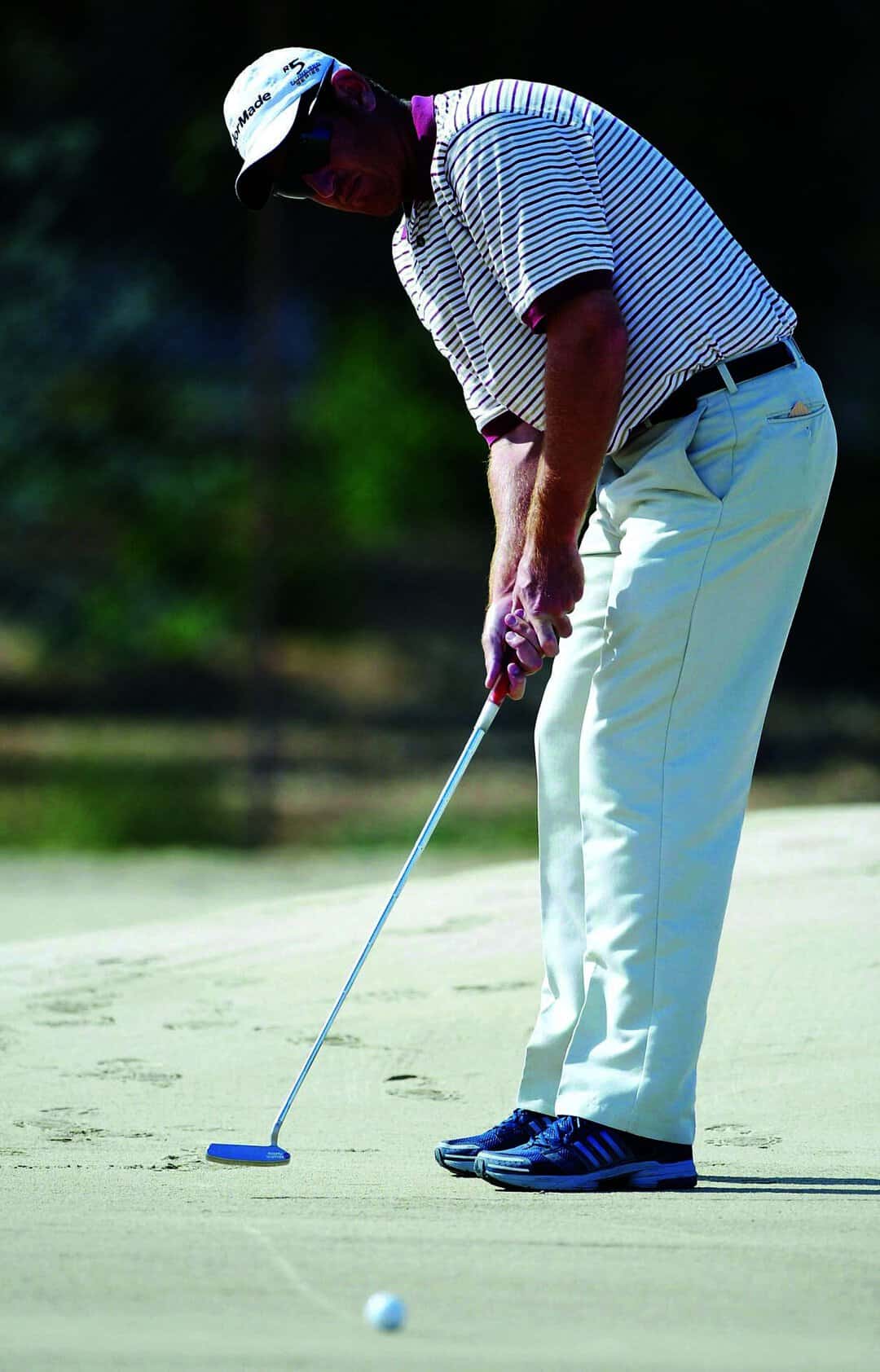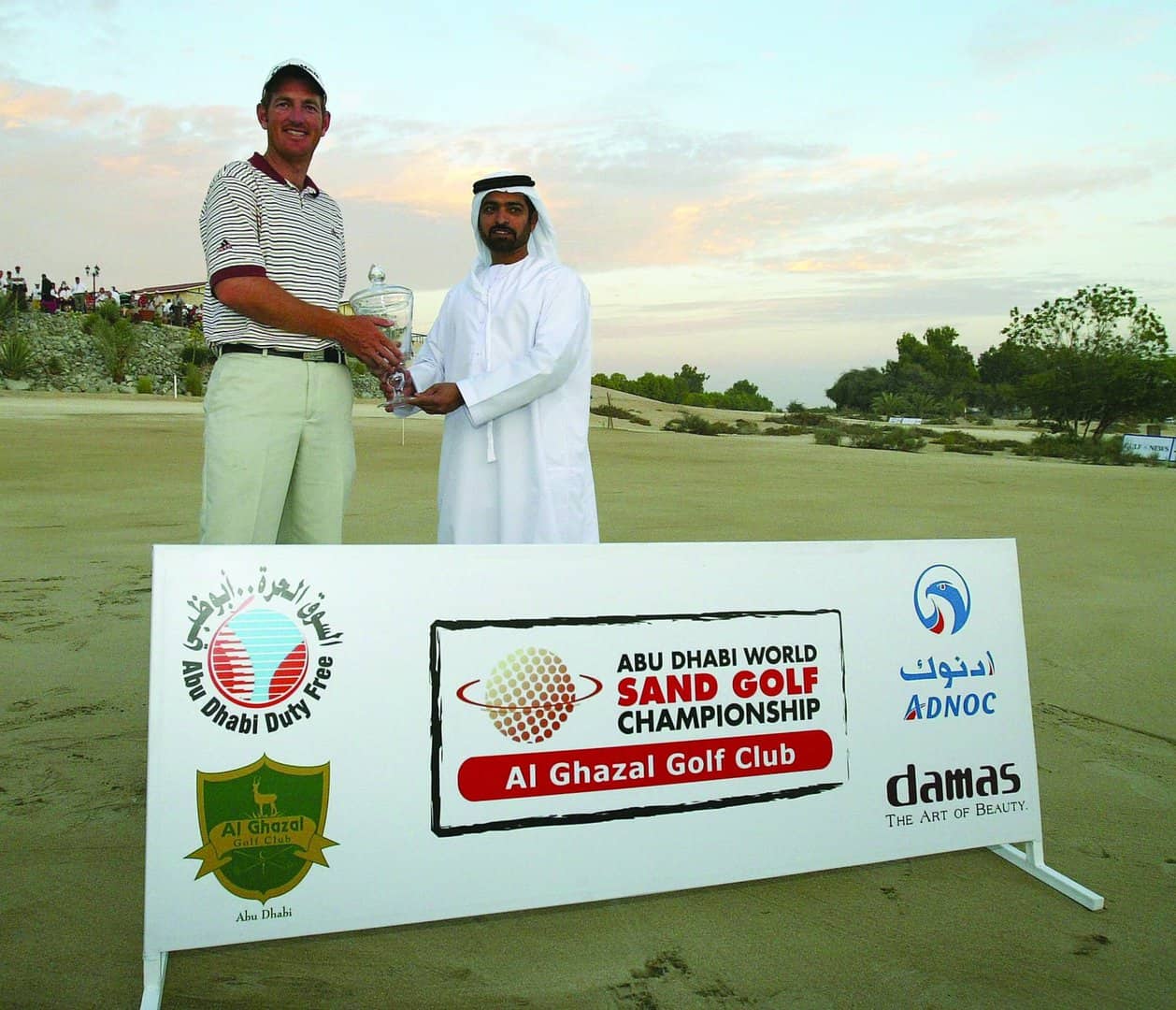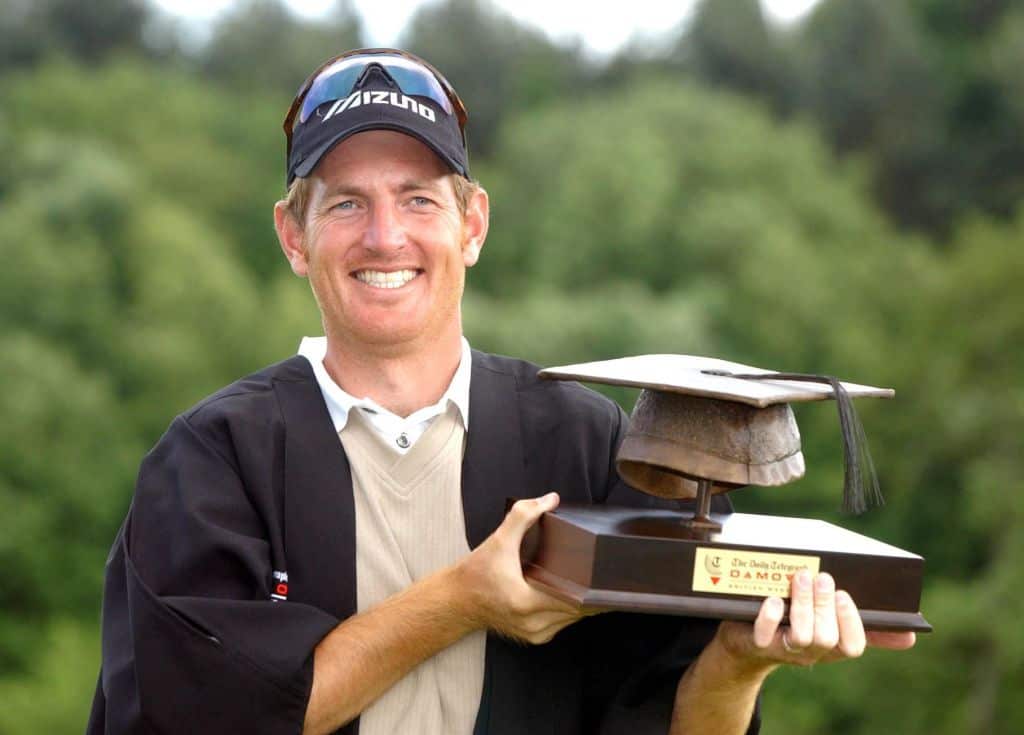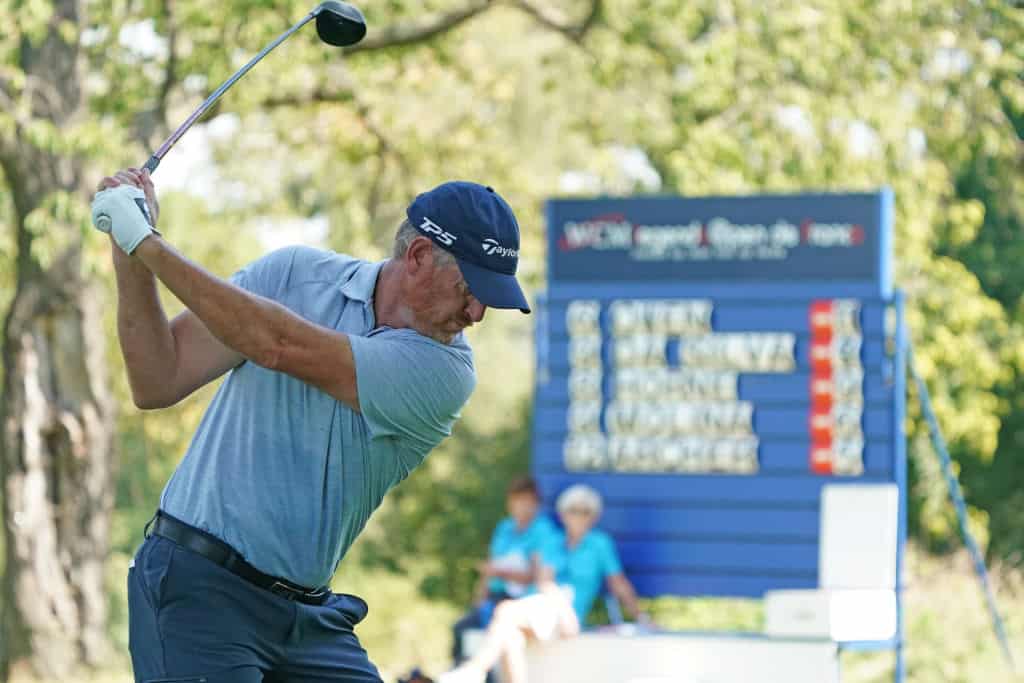Thomas Wragg caught up with the former PGA & DP World Tour player to reminisce on his victory at the inaugural Abu Dhabi World Golf Sand Championship in 2004 and to find out how he is enjoying the game once more after six years away from the sport following a series of struggles off the course.
Before getting in contact with Greg Owen last month, I wasn’t as familiar with his story as I probably should have been.
I was aware he had been a winner on the DP World Tour at some stage in his career and had played The Open Championship and PGA Championship on numerous occasions, but it wasn’t until I was diving into research for a feature on sand courses in this region that I discovered the Englishman was the inaugural winner of the Abu Dhabi World Sand Golf Championship in 2004, but this just would be the start of a fascinating and courageous story.
Held under the patronage of H.E. Sheikh Hamdan Bin Mubarak Al Nahyan, then chairman of the Department of Civil Aviation, the one-day Abu Dhabi World Sand Golf Championship took place between the Dubai Desert Classic and Qatar Open at Al Ghazal Golf Club.
With nothing planned for that week, Owen, alongside greats of the game including Sir Nick Faldo, Padraig Harrington and Ian Woosnam, arrived at the sandy par-71 layout, which measured 6,700 yards, to play on the unusual terrain for the very first time.
“We were playing in Dubai and Qatar around that time and then we heard about the opportunity to play in the World Sand Golf Championship,” said Owen when we caught up on Zoom before his outing at the WINSTONgolf Senior Open last month.
“I just thought it sounded like a lot of fun and intriguing more than anything. It was something different, I had never heard of playing golf on sand courses before. My first job out of school was at a driving range, so hitting off mats was quite a natural feel for me.
“I remember being overwhelmed and shocked at playing a golf course with no greenery anywhere, it was really weird, but it was a fun day.”

Rather than playing on the perfectly manicured Majlis course or at the serene Doha Golf Club, players went to battle around a track that had a front nine based on an archaeological site on what, thousands of years ago, was the original Abu Dhabi coastline.
The back nine was constructed on flatter reclaimed land which featured customary hazards of water and rough on numerous holes. If that wasn’t enough of a challenge, players also had to contend with the numerous burrows dug by desert lizards known as dhubs.
Then there was the course’s signature hole to tackle – the `Off-Road’ 17th which was loosely modelled on the infamous Road Hole at St Andrews. This was the only hole where the ‘brown’ – a sand course version of a green – was situated well into the desert and had to be reached by the players in a Land Rover.
“The main difference been grass courses and sand is the definition,” says Owen.
“Having played most of my career on the PGA Tour, the courses are so finely manicured, while in the UK you get a lot of links style courses where you can kind of tell what the hole is asking of you.
“Whereas Al Ghazal’s fairways were staked out, so you had to basically hit it between the stakes. If you did, you got the opportunity to play off the mat which you carried around with you, but if you weren’t accurate from the tee, you had to play it as lied and there were footprints and all sorts to contend with.
“Luckily for me, around that time, my strength was driving, so I played off the mat quite a lot.
“Having said that, putting was the real fun side of things as you’d have a guy going around the course with you who swept the browns after you’d played so each one was in fantastic shape.
“They were great to practice your putting on because you could see the lines the ball made after you took your stroke. If you were aiming a putt right to left and it didn’t go in, you could see if you hadn’t hit the ball in the right place or if it had skipped or rolled. I actually came away from that day learning a lot about my putting due to those browns.”
Owen adapted to the new surroundings a lot quicker than the other 31 professionals, posting a course-record 64 to edge out Norway’s Henrik Bjørnstad by a shot before being presented with the trophy and a cheque for a tidy $10,000. There was also time to celebrate the victory by sampling a local delicacy.
“It came as a complete shock to win it as it was a totally new concept,” he says.
“Things can get a little monotonous on Tour doing the same thing over and over, so it was nice to have a new challenge and come out on top. It’s fun to say ‘I’m the first ever World Sand Championship winner’, it’s a pretty cool thing.
“I also got to meet the Sheikh and eat camel for the first time, which was a lot nicer than I expected.
“Obviously winning the money was a nice bonus for a fun day put on the course as well. Prize money has gone up a little bit more than that now! It’s crazy what has happened to the game. I thought I was playing through a really good spell with Tiger increasing the prize money out on Tour, but now these last couple of years it’s really gone through the roof.”

Victory in Abu Dhabi’s desert was the second in the space of a year for Owen, who had picked up his maiden victory on the then European Tour in 2003 on his 158th start at the British Masters.
But soon after conquering the desert, a serious back injury, which would go on to cause many more problems during his career, interrupted his season.
Owen would return to the British Masters to defend his title, needing painkilling injections to do so, before having surgery on a bulging disc in his back which kept him out of action for three months.
“2004 was a rough year for me,” he says.
“I was in a really good place after winning the British Masters in 2003 and then the World Sand Golf Championship but then the injury came which really jolted that year.

“The one good thing that stands out was between the win in Abu Dhabi and my injury problems, I put a deposit down on a house in the States so I could practice out there in the winter. When I was closing on the house at the end of the year, I entered PGA Tour Q-School, got through all three stages and have stayed out there ever since.”
Owen took to life in the States like a duck to water. In his maiden season he became the first rookie to reach $1m in earnings in a single season, posting three top 10s in 24 starts, including a headline-grabbing third place in only his third event.
“Those first two years on the PGA Tour were the most fun times I ever had playing the game,” he added.
“I was playing well, everything was new and fresh plus the crowds were amazing. Every week felt like the current tournament was trying to outdo the previous event.”
Over the course of the next 12 years, Owen bounced between the PGA Tour and what is now known as the Korn Ferry Tour, playing a total of 266 events on the top American circuit and 63 times on its feeder Tour.
Issues with his back were a mainstay throughout that period, but it wasn’t until 2017 that he fully came to terms with another issue that had potentially hampered his career.
“I stopped playing in 2017 after being diagnosed with depression,” he says.
“I finished second twice in 2017 on the PGA Tour and I still lost my card. It was the first year that money wasn’t counted, it was just FedExCup points and the two events I finished runner-up in were opposite field events, so there weren’t too many points up for grabs.
“I was feeling a lot of stress. My kids were getting older, I was missing out on watching them grow up as I was still putting the work in and things weren’t going my way. I was also having trouble with my back, so the PGA Tour allowed me to take some time off for myself.
“It’s amazing how it can just creep up on you and catch you out at the worst times. Sometimes you can just wake up in the morning, and nothing has happened, but you feel down.
“Since being diagnosed with depression, I’ve done a lot of talking with my therapist and we looked back to 2007. I lost my manager, caddy and coach in that year after having quite a rough season – it left me feeling like I had been abandoned.
“From then on, I had some really good years and tournaments, but it felt like work which took its toll after a while.”

To make matters worse, Owen’s back problems were starting to get worse with every day that passed. The crippling pain made getting up in the morning difficult and swinging a club nigh on impossible – a trip to an expert was needed to aid both his physical and mental wellbeing.
“I went to see a specialist, Tiger’s surgeon, who did some tests and concluded I needed surgery,” he says.
“I underwent more spinal surgery in 2019, where they did a fusion and put two artificial discs in my lower back. They basically reconstructed my lower back.”
“I then went through a divorce and when I reached the age of 50, I thought I had to get back to doing what I know how to do. I wanted to rebuild my career, I didn’t want my story to finish how it did.”
Despite being knocked down numerous times in recent years, Owen has refused to let injuries and mental illness get the better of him.
After six barren years away from the game, the then 50-year-old returned to competitive golf at last year’s Senior Open Championship, where he finished in a share 53rd. Owen followed that up with a tie for 15th at the Legends Tour’s JCB Championship, before his heroic return was temporarily halted after developing two blood clots on the flight home from the tournament.

Despite the most recent setback, Owen made a full recovery and was back on course again in June of this year at the Jersey Legends. Since then, he has played five more events on Europe’s over 50s Tour, posting four top tens, including a runner-up finish at the Staysure PGA Seniors Championship – one of the highest tiered events on the Legends Tour International Schedule outside of the Senior Majors.
“I feel like I’ve still got something to give to golf,” he says.
“This is my first full year back, a kind of let’s see what happens kind of year.
“It’s all coming back. The last few weeks have been pretty amazing and surprising.
“I’m playing well and I’m quite confident, which is not something that I would have thought at the beginning of this year. I just wanted to see if I still enjoyed playing and competing because as I said, there’s been a lot of negative thoughts about it all over the last few years.
“I have good days and bad days. I’m starting to feel a lot more like myself now – good and bad. I had a rough day in France last month and the old feelings come back when you have one of those, but I’m strong enough right now to deal with that, put it to the side and move on.
“I just want to give my kids the opportunity to grow and do what they want to do with their lives.”
Now in a better place, both mentally and physically, than he arguably has been for the last 20 or so years, Owen’s next goal is to play his way onto the PGA Tour Champions next season by taking on Q-School next month.
It’s the next piece of the puzzle on what has been a truly remarkable return to golf’s professional ranks. He may have been battered and bruised along the way, but you won’t keep this courageous Englishman down for too long.
